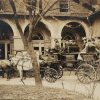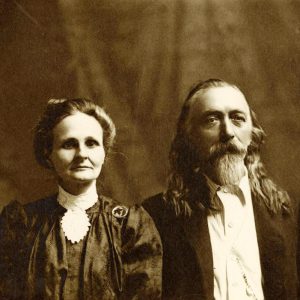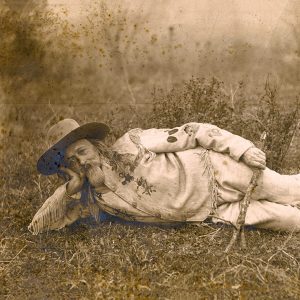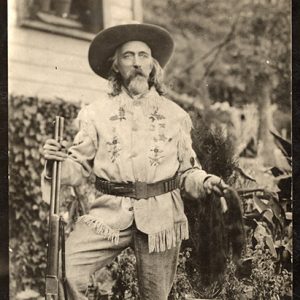calsfoundation@cals.org
Charles Ludwig "Old Scout" Von Berg (1835–1918)
Carlos Ludwig von Berg was a German immigrant, a Civil War soldier, a postwar scout during the last Indian Wars, and an artist and guide who settled in the Fayetteville (Washington County) area later in life. He was featured in the 2012 documentary Up Among the Hills: The Story of Fayetteville.
Carlos Ludwig von Berg was born on October 18, 1835, in the Duchy of Baden, where his family members were foresters. His first schooling was in Karlsruhe, followed by the University of Heidelberg. His studies were interrupted by the 1848 revolutions that caused his family to flee to Switzerland. He returned to Heidelberg but in 1854 immigrated to the United States.
He traveled west, and he took up trading for hides and furs with Minnesota Native Americans and using his drawing skills to do portraits on deer skins. He spent much time among the Sioux. He married Bridget Mary Bird in 1861, settling her in McGregor, Minnesota. Although hostilities between incoming American settlers and the tribes were increasing, von Berg enlisted as C. Louis von Berg in Company D of the Twenty-Seventh Iowa Infantry at the beginning of the Civil War. However, he was immediately diverted into scouting duties.
Upon returning to his regiment, he was elevated to the rank of corporal but later asked to become a private. He served in Arkansas and then under General Nathaniel Banks in the Red River Campaign. He was mustered out at the end of the war.
He began homesteading near LeMars, Iowa, but he soon turned to serving as a guide for wealthy visitors, most notably that of Russian grand duke Alexei Alexandrovich in 1872. Von Berg’s many scouting assignments led to the title of “Captain” von Berg, a scouting honorific without any military significance. To the tribes, he was “Eagletail.”
On June 25, 1876, he was carrying a message to General George Armstrong Custer when he met a Crow scout, “Curley,” the only survivor on the federal army’s side at the Battle of the Little Bighorn. Von Berg then investigated the scene. Later, he painted a portrait of Curley.
As the Indian Wars were ending and the supply of wild game was dwindling, William Cody, a.k.a. “Buffalo Bill,” turned his skills into creating Wild West shows; von Berg, however, rejected Buffalo Bill’s offer to work in his show and retired to Goshen (Washington County) outside of Fayetteville, accompanied only by his youngest son. Following a divorce from his first wife, he married Martha Louisa Mayes in 1889. In addition to his farm, he found work as a whiskey gauger (excise-tax collector). He visited Buffalo Bill’s camp when the show came to Fayetteville in 1898 and met many old friends.
Although the U.S. government ended the use of gaugers, von Berg did receive a pension for his Civil War service. In 1904, he and his wife moved into a “lodge” of three small rooms he built halfway up East Mountain facing west; even twenty-six years later, it could be reached only by a bridle path. On his first night there at 9:00 p.m. he took out his bugle and played Daniel Butterfield’s “Taps.” He unfailingly continued this practice, and even after his death, locals swore they still heard it.
In the lodge, he designated a room to hold items he had collected over the years. A sign read: “von Berg Museum, admission 25 cents.”
The early twentieth century saw a rising interest in the “rugged life” and Western art. The Wild West shows hired Indians to play roles, and visitors saw battles acted out but also could tour reconstructed Indian villages and witness native crafts. The scouting movement for youth followed, and von Berg embraced it in Fayetteville, becoming the town’s first scoutmaster. The troop built a cabin nearby, and von Berg shared his saddles, guns, and war trophies with the young people. One scout, Paul K. Heerwagen, later wrote von Berg’s biography, which has photographs of von Berg’s paintings, most notably of the Crow scout Curley. In 1916, the Abilene Daily Reporter sent a reporter to visit von Berg, and the Arkansas Gazette published a large spread with a picture the following year.
Von Berg died on March 2, 1918, and is buried in the Fayetteville National Cemetery. (His headstone shows death date as March 3.)
Von Berg’s collection was donated to the University of Arkansas Museum, which closed its public functions in 2003. Although the materials were warehoused, attempts to determine the exact holdings proved unsuccessful. Some of von Berg’s photographic materials were given to the Shiloh Museum of Ozark History.
In the 2012 documentary Up Among the Hills: The Story of Fayetteville, a reenactor played “Taps,” as “Old Scout” von Berg had done each night after settling on East Mountain.
For additional information:
Heerwagen, Paul K. Indian Scout—Western Painter; Captain Charles L. Von Berg. Little Rock: Pioneer Press, 1969.
“The Last of the Frontier Scouts.” Arkansas Gazette, October 28, 1917.
“Story of the Curfew Blower of the Ozarks.” Abilene Daily Reporter (Abilene, Texas), September 17, 1916.
Michael B. Dougan
Jonesboro, Arkansas









It seems nobody knows the whereabouts of the Von Berg collection since it closed its public functions. If anyone knows where the his legendary gun “old Betsy” and his many other epic artifacts may be now, please let me know.
I would be very interested to know more about a photo of Carl’s sword from the Civil War. I believe Carl or Charlie is my cousin. I had the opportunity to look at some of his moments at the University of Arkansas a couple of years ago and went to his grave. I have some other information.
This is my great-great-grandfather.
I am a descendant of his daughter, who was his first child, Anna Von Burg or married name of Anna Henry. She is buried in Emmetsburg, Iowa. My dad has Von Berg’s Civil War sword and I believe the painting of Curley, along with a few other original paintings.